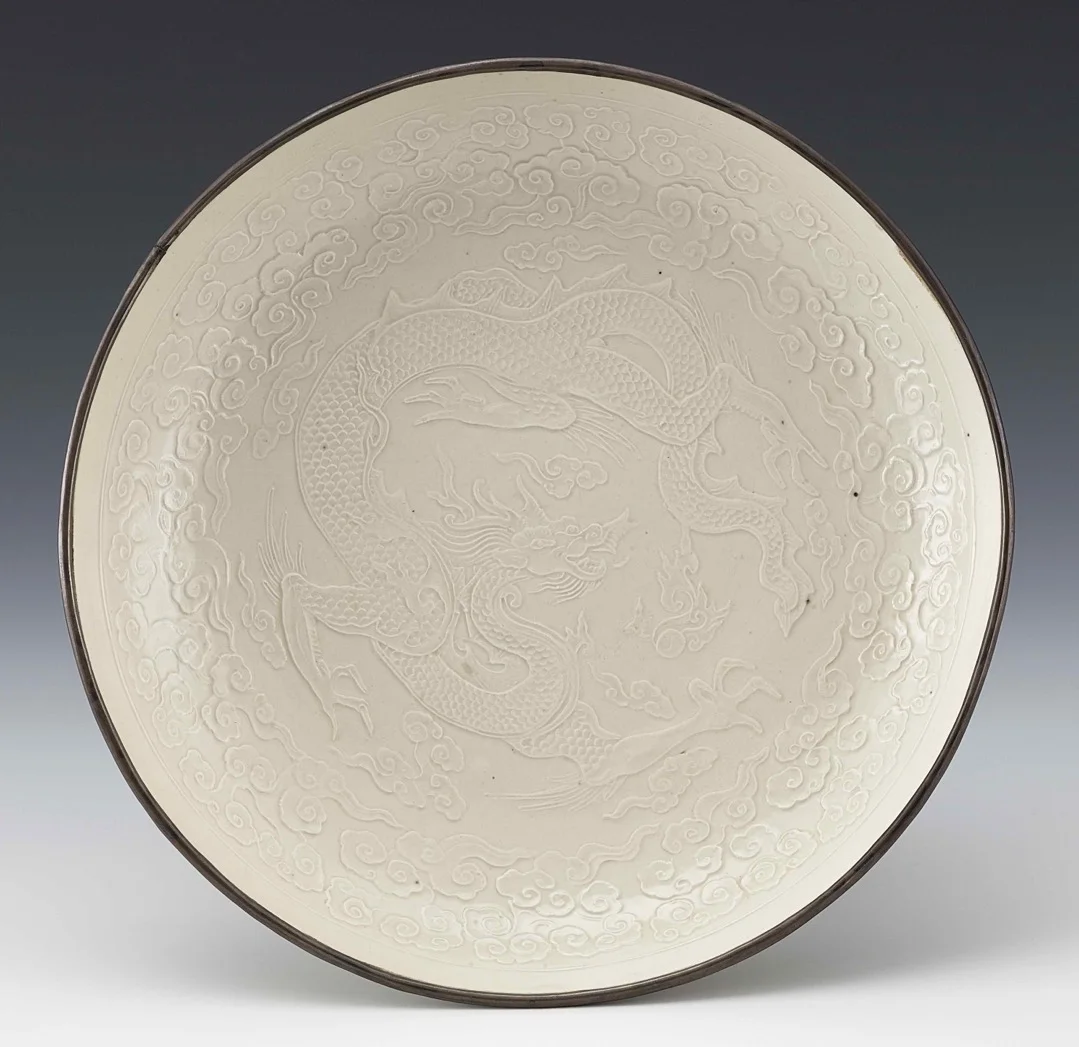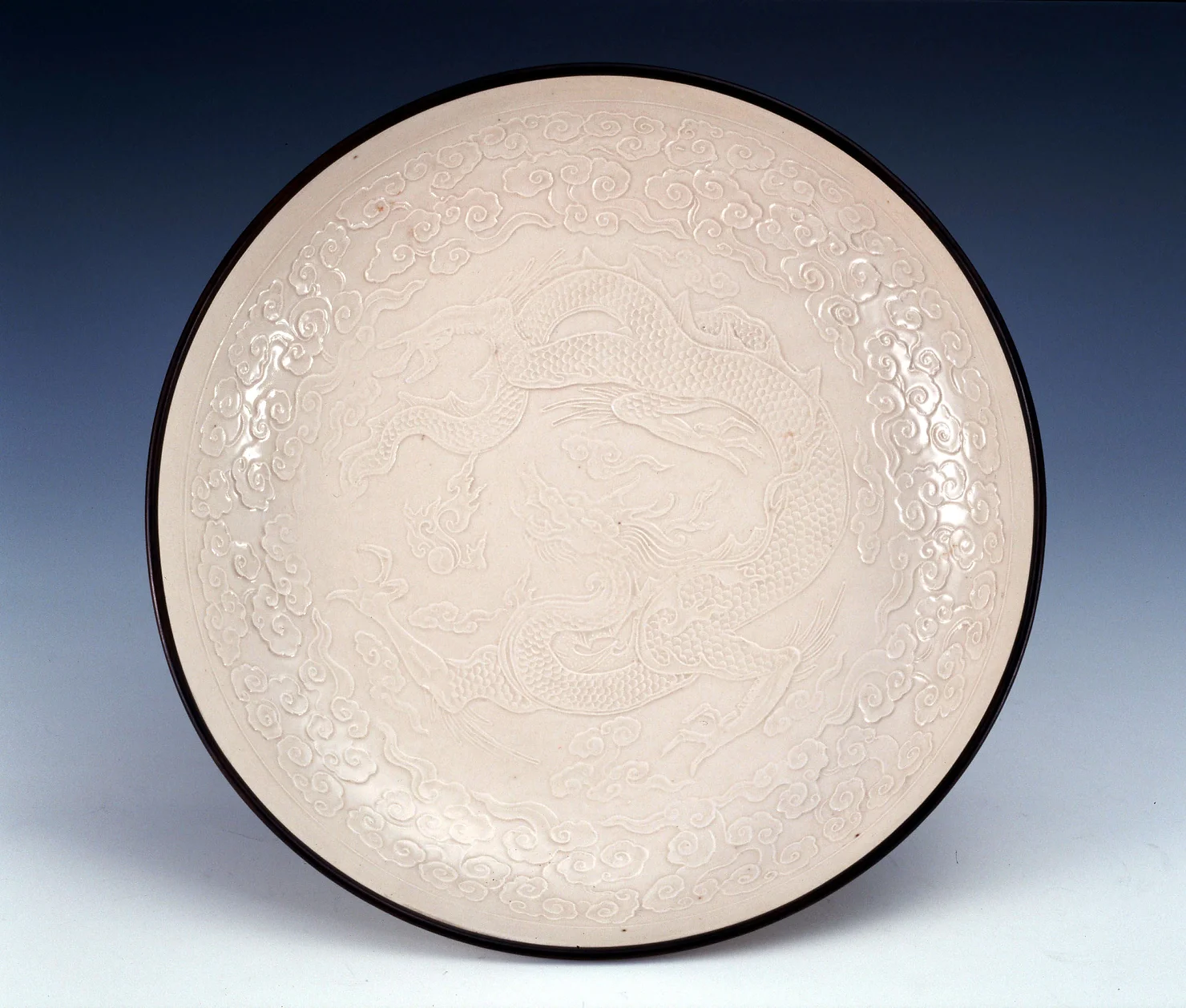宋代筆記 vol.85 坂本五郎舊藏定窯9.6萬美金(70萬人民幣)白釉印花「穿花鴻雁」紋盌 - The ‘Sakamoto Goro ‘Ding' White-Glazed 'Geese' Bowl
- SACA
- Sep 19, 2024
- 3 min read
這件印花定窯描繪了大雁(或鵝)在花卉地中飛翔的場景,以模製設計的深度和清晰度而著稱。
定器傾向於模仿其他珍貴的材料,如漆、金、銀等,這些材料都儲藏在宮廷的寶庫中。從北宋晚期(十二世紀初)開始,定器工匠不再使用手工雕刻的裝飾,而是使用類似鑄造金銀器的模具。在修整邊緣之前,先將黏土壓在浮雕裝飾的模具上,以確保器物既能保持形狀,又能保持珍貴材料的輕薄。這種新技術可以製造大量的器皿,從而滿足市場的需求。
參考:
這類花鳥圖案也顯示了紡織品對模印定器的影響,它與當時豐富的錦緞紡織品很相似。
台北故宮博物院藏有一件相關的雲頭瓜蔓鵝紋碗,圈足為素面,收錄於台北故宮博物院所藏白定窯器展,2014,編號 II-150。II-150, 以及另一件描繪鴛鴦與魚的,編號 II-151. II-151. 相關形式的碗,飾以不同種類的鳥和花卉,包括鮑爾收藏的鳳凰、蓮、魚圖案,發表於John Ayers, The Baur Collection, 第一卷,日內瓦,1968年,圖版A18;以及Jan Wirgin, Sung Ceramic Designs, 斯德哥爾摩,1970年,圖版85a牛津東方藝術博物館收藏的鳳凰、花卉圖案和圖版89a倫敦維多利亞與亞伯特博物館收藏的鴨子、蓮、魚圖案。河北省曲陽縣定窯遺址出土的鳳凰牡丹紋碗碎片,曾參加「定瓷器」展覽。白色優雅的世界 - 最近的考古發現》,大阪東方陶瓷博物館,2013 年,cat. no. 44.
一件刻有鳳和花的定窯碗模,背面刻有 1184 年的銘文,由 Percival David 爵士收藏,現藏於倫敦大英博物館,參見 Margaret Medley, Illustrated Catalogue of Ting and Allied Wares, London, 1980, pl. 46。
蘇富比紐約
September 19, 04:03 AM HKT
Estimate
80,000 - 120,000 USD
Lot Sold
96,000 USD
metal mounted rim, Japanese wood boxes (5)
Diameter 7½ in., 19.1 cm
Provenance
Collection of Sakamoto Gorō (1923-2016).
Sotheby's New York, 17th March 2015, lot 9.
Catalogue Note
This intricately rendered scene of geese flying within a floral ground is notable for the depth and clarity of the molded design. Ding ware tended to imitate other precious materials such as lacquer, gold and silver, quantities of which were stored in palace treasuries. From the late Northern Song period (early twelfth century), Ding-ware craftsmen moved away from hand-carved decoration to using mushroom-shape molds which were similar to those used for casting gold and silver vessels. The clay was pressed onto the relief-decorated mold before the edges were trimmed down to ensure the wares retained the forms as well as the thinness and lightness of precious materials. This new technique allowed for the manufacture of a large number of vessels, thereby satisfying the needs of the market.
Bird and flower designs of this type also reveal the influence of textiles on molded Ding ware, which bears a resemblance to rich brocaded textiles of the period. A related bowl impressed with geese among clouds and melon vines, but with a plain circular rim is preserved in the National Palace Museum, Taipei, included in the Museum's exhibition White Ding Wares from the Collection of the National Palace Museum, Taipei, 2014, cat. no. II-150, together with another depicting Mandarin ducks and fish, cat. no. II-151. Bowls of related form, decorated with various species of birds among flowers, include a foliate example impressed with phoenix, lotus and fish, in the Baur collection, published in John Ayers, The Baur Collection, vol. 1, Geneva, 1968, pl. A18; and two illustrated in Jan Wirgin, Sung Ceramic Designs, Stockholm, 1970, with phoenix and flowers from the Museum of Eastern Art, Oxford, pl. 85a, and with ducks, lotus and fish, pl. 89a, from the Victoria and Albert Museum, London. Shards of a bowl decorated with phoenix and peonies, excavated from the Ding kiln site in Quyang County, Hebei province, was included in the exhibition Ding Ware. The World of White Elegance – Recent Archaeological Findings, The Museum of Oriental Ceramics, Osaka, 2013, cat. no. 44.
For a Ding bowl mold, incised with phoenix and flowers, the reverse incised with an inscription dating it to 1184, from the collection of Sir Percival David and now in the British Museum, London, see Margaret Medley, Illustrated Catalogue of Ting and Allied Wares, London, 1980, pl. 46.


















Comments